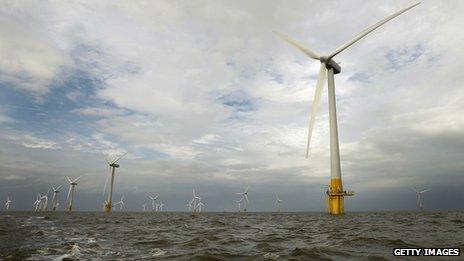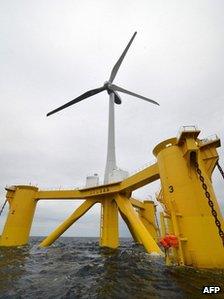Offshore wind farms face uncertain future
- Published

Atlantic Array's 1.2GW was part of 32GW of planned offshore wind capacity
Coming just days after the prime minister allegedly described levies to boost renewable energy generation as "green crap", blaming RWE's decision to pull the plug on the UK's largest offshore wind farm on government indecision would be easy.
Particularly so given the widespread questioning within the coalition of green subsidies that power companies argue are a major factor behind recent rises in energy bills.
Without the certainty of government support, companies are far less likely to commit the huge sums of money necessary to develop and build large-scale wind farms.
But, according to the company itself, this conclusion is completely unfounded. "Politics has nothing to do with it," says RWE spokesman Steve Thomas.
"Atlantic Array is a unique project, with the full remit of technical challenges - the currents, seabed and depth of water [are all working against us].
"We have undertaken a huge range of surveys that have now been completed.
"To make the project viable, we would need the next generation of technology - technology that is not available at the minute. The costs are prohibitively high."
To reinforce the fact, RWE points to its other offshore wind farm projects, all of which are still on the table.
Together, Gwynt Y Mor, which is due for completion next year, Greater Gabbard and Gallopor, both of which have planning consent, should generate more than 1.4 gigawatts (GW), compared with Atlantic Array's 1.2GW. The company has a further 3.8GW in the pipeline.
There is currently 3GW of installed offshore capacity in the UK.
"Offshore wind is one of the key strategic objectives for RWE and the UK has a significant role to play," says Mr Thomas.
'Disappointing'
But others within the industry are sceptical of RWE's reasons for pulling out, and are less willing to dismiss the role of politics.
Recent questioning of green subsidies may be "unwelcome political noise", but the seeds of doubt were sown last year, according to Dr Gordon Edge, director of policy at Renewable UK.
"RWE's decision is disappointing, but it is a direct consequence of the Levy Control Framework announced in November last year," he says.
"By 2020, there is a maximum of £7.6bn a year to be taken out of [energy] bills for renewable and nuclear generation, so there are only so many projects that can be funded."
Dr Edge recognises the technical challenges involved in Atlantic Array, but believes government policy is creating uncertainty for investors. In fact, he says, RWE's decision "should not be a huge surprise", particularly given the financial difficulties it finds itself in.
Heavy losses

Floating turbines are being tested as an alternative to fixing to the seabed
The German parent company has debts of about 30bn euros ($40bn; £25bn) and earlier this month announced it was cutting 6,750 jobs to help cut costs by 1bn euros.
The company has also decided to build no new nuclear power plants outside Germany, as it sees the financial risks as too high.
This may be why RWE has taken such drastic action in turning its back completely on the project.
Instead of parking it until the next generation of technology - such as floating wind turbines - becomes available, or trying to secure planning consent with a view to selling it on, RWE has shelved the project entirely.
"RWE will have lost tens of millions as the project is essentially now worthless. It has clearly made the decision there is no point spending any more," says Dr Edge.
The company itself dismisses such reasoning out of hand. "The wider [financial] situation of the company has had no impact on the decision," says Mr Thomas.
"From a technical and economic viewpoint, the project simply did not make any sense."
'Healthy attrition'
Whatever the reasons, more proposed wind farms will undoubtedly be shelved, although perhaps not in such a dramatic manner as Atlantic Array.
There are currently more than 32GW of offshore wind farms planned in the UK, more than 12GW of which are awaiting planning consent.
According to the Crown Estate, the body responsible for giving permission to develop offshore wind farms, current government guidelines suggest it wants between 8GW and 16GW installed by 2020.
"This means we will begin to see a healthy attrition as the UK pipeline moves... towards a figure more in line with the government's current thinking for offshore wind," Huub den Rooijen, the Crown Estate's head of offshore wind, said this weekend.
As Dr Edge argues: "More people are beginning to realise that not all projects can happen. I wouldn't expect too many handbacks, but more projects are going to be shelved."
As more wind farms move from concept to reality, some will inevitably fall by the wayside.
But uncertainty always discourages investors, and until the government agrees on a clear policy for encouraging cleaner energy generation, more companies might decide building offshore wind farms is simply not worth it.